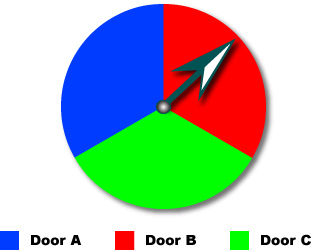The Situation
Pose the following situation to the students:
During a certain game show, contestants are shown three closed doors. One of the doors has a big prize behind it, and the other two have junk behind them. The contestants are asked to pick a door, which remains closed to them. Then the game show host, Monty, opens one of the other two doors and reveals the contents to the contestant. Monty always chooses a door with a gag gift behind it. The contestants are then given the option to stick with their original choice or to switch to the other unopened door.
In groups, students can discuss what they might do.
The Problem
As a class, discuss the following strategies.
If you were the contestant, which of the following strategies would you choose, and why?
Strategy 1 (stick): Stick with the original door
Strategy 2 (flip): Flip a coin, stick if it shows heads, switch if it shows tails
Strategy 3 (switch): Switch to the other door
An Instructional Approach
A good way to attempt to solve probability problems is to proceed from guesses to experiments to computer simulations to theoretical models. Students should first make a guess about the best strategy--stick, flip, or switch. Then, the students should carry out an experiment, modeling the decision task with coins, dice, spinners, or random numbers. Next, the use of a computer program that simulates the hands-on experiment may be in order to perform large numbers of trials for the experiment. Finally, depending on the background of the students and the difficulty of the problem, it may be appropriate to model the problem theoretically.
In Monty's dilemma, the simulation step is absolutely crucial to enable our students to understand exactly what occurs within each of the three strategies. Using an equal-area spinner and a coin, we can model each of the three strategies. To determine which of the three strategies yields the best chance of winning the prize, we should play each strategy many, many times and keep a record of the outcomes. Let us suppose that the prize is actually hidden behind door A, as shown in the figure below. Remember that Monty must show us one of the doors without a prize behind it.

Spinner for Monty Simulation
Alternatively, students may use the Adjustable Spinner interactive.
 Adjustable Spinner
Adjustable Spinner
Let's walk through a simulation of each strategy.
The Stick Strategy
- Suppose that the spinner lands on door B. What does Monty do? (Shows you door C) What do you do? (Stick) Do you win or lose?
- Suppose that the spinner lands on door C. What does Monty do? (Shows you door B) What do you do? (Stick) Do you win or lose?
- Suppose that the spinner lands on door A. In this instance Monty shows you either door B or door C. What do you do? (Stick) Do you win or lose?
The Flip Strategy
- Suppose that the spinner lands on door B. Then Monty opens door C. You then flip a coin to decide whether to stick with door B or switch to door A. What is your chance of winning the prize?
- Suppose that the spinner lands on door C. Monty opens door B. You flip to decide between A and C. Again, what is your chance of winning the prize?
- Suppose that the spinner lands on door A. Monty opens B or C. You flip to decide between A and the other door. Once more, what is your chance of winning the prize?
The Switch Strategy
- Suppose that the spinner lands on door B. Monty opens door C. You switch to the unopened door. Do you win or lose?
- Suppose that the spinner lands on door C. Monty opens door B. You switch. Do you win or lose?
- Suppose that the spinner lands on door A. Monty shows you door B or C. You switch. Do you win or lose?
(Teacher Note: If you desire a somewhat simpler version of this activity, eliminate the flip strategy.)
We recommend that each student use the spinner to run at least 100 trials under each of the three strategies. This activity has a very powerful effect on their understanding of the problem. After many trials, the relative frequency of winning under each strategy gives an experimental estimate for the theoretical probability of winning the prize under each strategy.
Go to the Simple Monty Hall Simulation to use an interactive applet to simulate individual trials of this situation. You will need to manually flip a coin at the proper time to simulate the flip strategy. To simulate a large number of trials, go to the Generalized Monty Hall Simulation. (Note, however, that you can only simulate the stick or switch strategies with the applet.) The results of playing Monty's Dilemma 100,000 times under each of the three strategies using a computer simulation are presented in the table below.
Monty's Dilemma: 100,000 Trials

What is the reason for the outcome? The big questions in Monty's Dilemma are (1) What do you know and (2) When do you know it?
In problem solving, looking at an extreme case can often lend valuable insight. Suppose Monty offered us a choice of 100 doors and behind only one of these doors was a fabulous prize. Then, after hearing your selection, Monty announces that the prize is either behind your original choice or behind another door, which he identifies at this time. Given the opportunity to switch choices, what would you do?
In this situation, more people are likely to favor the "switch" strategy. Their reasoning may go like this. "My original choice has a 99 percent chance of being wrong. That means that the other door Monty offers has a 99 percent chance of being right!" A computer simulation of this modified problem supports this analysis. Similarly, in the instance of the three doors, since the probability is 2/3 that your original choice was wrong, the probability is 2/3 that the great prize lies behind the door that remains after Monty opens a door to a gag gift. Nevertheless, many people are quite convinced that the probability is at best 1/2, even after they are offered the choice to change doors. Let us undertake a careful analysis of the spinner simulations using tree diagrams.
Once again, assume that the prize is behind door A. We spin the spinner to make our initial choice. There is a 1/3 probability of (randomly) choosing each door. Monty must reveal a gag gift behind a remaining door. In the event we chose door A initially (the one with the prize), Monty can show us either B or C. We assume that the probability is 1/2 that Monty will show us B and 1/2 that he will show us C. If we chose B, Monty must reveal door C and leave A. If we chose C, Monty must reveal door B and leave A. Thus, initially, we obtain the tree diagram in the figure below.

We can complete this diagram in three different ways, corresponding to each of the three strategies, stick, flip, or switch. The stick and switch strategies determine immediately which door is finally chosen along each of the branches. The flip tree requires adding two more branches at every node, each with a probability of 1/2 that we either keep our original choice or take Monty's offer to switch. The three trees are shown in the figures below, with the final probabilities computed for each end branch by the usual multiplication principle. Again, without loss of generality, we assume that the prize is behind door A.

Stick-strategy tree diagram for Monty's dilemma

Switch-strategy tree diagram for Monty's dilemma

Flip-strategy tree diagram for Monty's dilemma
When we tabulate the probabilities of ending up with a final choice of door A, B, or C, we find that the three strategies all yield a different result, as shown in the table below.
Analysis of the Stick, Flip, and Switch Strategies

Actually, the way most people respond initially to this problem is not all that surprising. Misconceptions of chance are common among students. Since this particular problem involves the process of revising our probability estimates in the light of new information about the doors, it involves conditional probabilities.